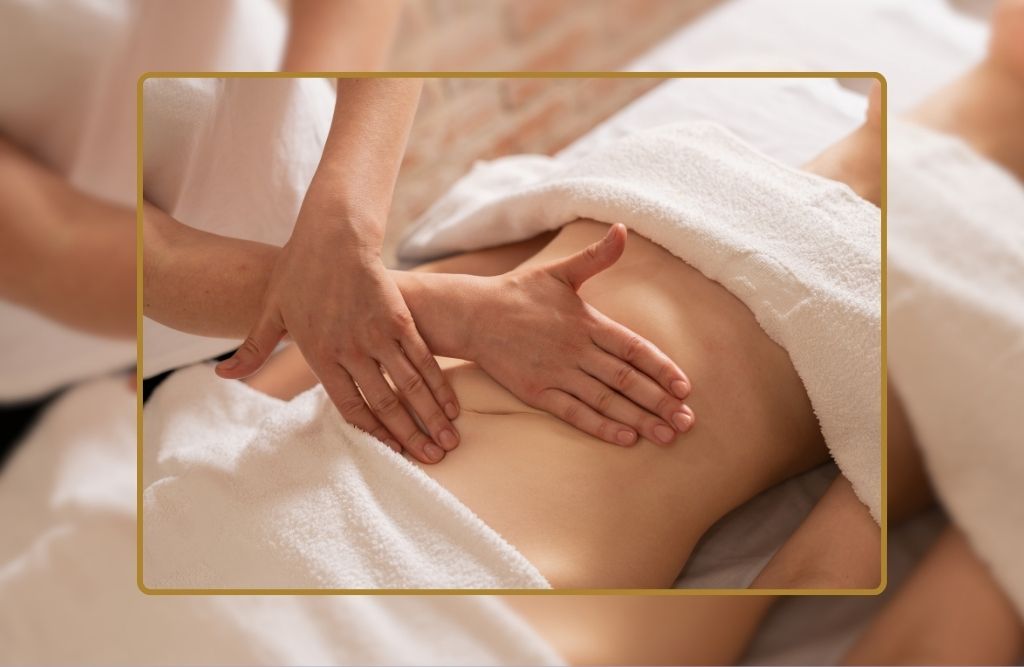I’ll be honest: I never experienced a lymphatic drainage massage before this. But after seeing it go viral all over social media (and those intense before-and-after sculpting shots), I was very, very curious. I booked an appointment at
Touch Massage Bar
, at its newest in Midtown Toronto location, with Rayanne Bartley, who’s been treating clients there for four years.
I didn’t know what to expect, but halfway through the treatment, I could actually hear things happening in my body. My abdomen sloshed and grumbled (Bartley explained I was experiencing some blockages). I could feel my insides moving up toward my sternum.
Curious if a lymphatic drainage massage could be right for you? Learn from my own experience and some expert insights to see if it’s something you might like to try.
Images by
Grow Digital
Lymphatic drainage massages vs deep tissue massages
I’m used to deep-tissue massages. I book them often for muscle recovery and to ease pain from things like bad posture or sleeping awkwardly. But this lymphatic experience was something else entirely. Instead of that satisfying deep pressure I normally crave, the lymphatic massage felt more like a rhythmic, intentional movement across my skin; it was almost meditative. It made me realize that while regular massage targets muscles, lymphatic drainage taps into something deeper, and both serve their own purpose.
With lymphatic drainage, the pressure was much lighter, but I could actually sense the fluid in my body moving, especially around my abdomen, and I knew it was helping. It wasn’t about breaking up knots; it was about helping my system flow better. Toward the end, I even felt my nose running.
Both types of massage have their place in my self-care regime now, depending on what my body needs: recovery for my muscles or a feeling of a reset for my whole system.
How are lymphatic drainage massages different from a regular massage?
During a deep tissue massage, the therapist uses firm, targeted pressure to work deep into muscles and fasciae, helping to break up knots and release chronic tension. In contrast, lymphatic drainage therapists use light, rhythmic strokes designed to stimulate lymph flow and move excess fluid through the body.
“Deep tissue is about muscles. Lymphatic drainage is about circulation,” explained Saira Lakhani, founder of Touch Massage Bar, “It’s not painful – it’s sculpting, it’s energizing.”
For some people, they will immediately need to use the washroom after their session is finished. I didn’t personally experience this, but I could see how some people would.
What is inflammaging and how do you avoid it?
How does lymphatic drainage massage work?
Unlike your circulatory system, your lymphatic system doesn’t have a heart to keep things moving; it relies on breath, movement and manual stimulation (massage) to help move around excess fluid in the body.
Lymphatic massage always starts with “pumping” the lymph nodes. Bartley began my session by gently stimulating the nodes in my neck to get the flow going. As she worked, she explained the difference between the main types of lymphatic drainage massage. Manual Lymphatic Drainage (MLD), which includes clinical methods, such as
Vodder, Foldi, and Casley-Smith,
This is a more gradual, very mild method frequently employed after surgery and for persistent swelling.
At Touch Massage Bar, however, the technique differs slightly. “Our lymphatic drainage massage draws inspiration from the Brazilian approach,” clarifies Lakhani. “This method is quicker and follows a more rhythmical pattern compared to conventional methods such as manual lymphatic drainage. Nonetheless, it maintains crucial movements for stimulating lymph flow, including pumping and sweeping actions.”
In contrast to a standard deep tissue massage, this approach aims at invigorating your system and supporting your body’s innate ability to cleanse itself. According to Lakhani, the objective is “to eliminate extra fluids, decrease swelling, enhance blood flow—resulting in an overall sensation of lightness and rejuvenation from within and without.”
How frequently should one schedule facials? How far ahead of an event do you need to start for that radiant look?—plus some common questions answered.
In what ways can lymphatic drainage massage enhance the immune response and reduce inflammation?
Stimulating the lymphatic system through massage can support your body’s ability to regulate inflammation more efficiently, reducing strain on the immune system over time.
“Lymphatic drainage massage assists in reducing swelling and inflammation in the body by improving the movement of lymphatic waste and decreasing bloating,” explained Bartley. But unlike your circulatory system, which has the heart to keep blood moving, your lymphatic system relies on movement, breathing, and manual stimulation to keep things flowing.
When the lymphatic system is working properly, it helps the immune system fight off infections and reduce swelling in tissues. According to the
Cleveland Clinic,
The lymphatic system significantly contributes to immune health by generating and distributing lymphocytes (a kind of white blood cell) along with other immune cells that seek out and eliminate threats such as bacteria, viruses, parasites, and fungi.
I’ve experienced inflammation related to food sensitivities—I noticed that consuming specific foods my body couldn’t handle resulted in bloating, fatigue, and persistent systemic inflammation lasting several days.
I shed 10 pounds – this is how I accomplished it
What advantages does getting a lymphatic massage offer?
If you’ve experienced that bloated, weighed-down sensation due to traveling, indulging in salty foods, or general lethargy, your lymphatic system could likely use a massage. Such a treatment aids in circulating fluids, enhancing blood flow, and leaves you feeling rejuvenated and less burdened. Personally, I noticed almost immediate improvements. Below are some advantages you might experience:
- May see an immediate reduction in bloating and puffiness
- May boost circulation for that natural, lit-from-within glow
- Could aid digestion and lessen feelings of lethargy
- Can help decrease inflammation following operations or treatments.
Who might benefit from trying a lymphatic massage?
To be completely upfront, I tend to get drawn into various wellness, beauty, and health fads I come across on platforms like Instagram and TikTok. Initially, what caught my attention were those eye-catching before-and-after clips where individuals appeared significantly less puffy following a single session of lymphatic drainage massage. However, apart from being influenced by this online buzz, I genuinely wanted to explore it because reducing inflammation through eliminating certain triggering foods has made me realize how much more can potentially be achieved. So, I thought, why not delve into something novel and push my outcomes even further?
Bartley suggests their lymphatic massage therapy for individuals dealing with:
- Having just experienced a surgery where edema may present
- A compromised immune system
- Conditions related to autoimmune issues causing inflammation
- Excessive or chronic bloating
- Poor circulation
Céla icy cold mud mask experience: Prepare for messiness
Can lymphatic massages be beneficial for particular health issues?
Certainly, and in numerous ways beyond what one might initially assume. As stated by
WebMD
, lymphatic drainage massage might assist with:
-
Lymphedema
Swelling caused by an accumulation of lymphatic fluid, typically following surgical procedures. -
Chronic venous insufficiency (CVI)
: Poor blood flow in the legs, leading to swelling. -
Fibromyalgia
A disorder characterized by pervasive ache and sensitivity across the body. -
Rheumatoid arthritis
An autoimmune condition characterized by inflamed joints. -
Lipedema
: A disorder characterized by abnormal fat accumulation, often in the legs.
For individuals managing long-term health issues, such as
lymphedema
(a form of inflammation resulting from an accumulation of lymph fluid), conventional Manual Lymphatic Drainage (MLD) techniques are frequently suggested by healthcare professionals. These procedures are generally carried out by practitioners who have received specific training, often in hospital or clinic environments, to address severe swelling and avoid potential issues.
Give viruses the cold shoulder by supporting your immune system with these supplements (all available in Canada).
Are there any risks?
Lymphatic drainage can be gentle and safe for most people, but it’s not for everyone. Bartley says that in pregnancy, lymphatic drainage may help manage fluid retention, but everyone should get approval from their health care provider first.
Anyone with a history of cancer, recent surgeries, congestive heart failure and/or unexplained swelling should also consult their healthcare provider before booking a session, just to make sure lymphatic stimulation is safe and a fit for them.
If unsure, always consult a healthcare provider before scheduling your appointment.
How often should you get a lymphatic drainage massage?
It depends on your goals, but here are some general rules of thumb shared with me at my appointment.
- For general wellness and detox: Once or twice a month
- For post-surgical recovery: Multiple sessions per week or as guided by your doctor
- Before a big event: Two to three days beforehand for peak results
“Everybody responds differently,” Lakhani says. “It’s to help stimulate the lymphatic system so your body can do what it’s naturally designed to do.”
Bookmark this! The best-selling health and wellness books in Canada.
How to boost your lymphatic health at home
Want to keep that post-massage glow (and de-puff) going? Lakhani says her clinic recommends doing the following:
-
Drink lots of water.
“Staying hydrated is essential.” Extra tip: include lemon or electrolytes for added benefits. -
Move your body.
Walking, yoga and strength training can stimulate lymphatic flow. -
Try cold plunges.
Alternate hot and cold showers. Start with two to three minutes of warm water, followed by 30 seconds of cold, repeat a few times. -
Try dry brushing.
Use a firm, natural-bristle brush (one that’s made for dry brushing – don’t chintz out, it’s not worth it). Gently brush your skin before showering. The motion helps exfoliate and stimulate lymphatic flow. -
Eat whole foods
and limit processed foods, excess salt and sugar. This can help prevent bloating.
Is lymphatic massage good?
Overall, it felt like the inflammation in my body was gone, and I felt comfortable in my body, and even moving seemed easier. I’m not saying this massage was the answer to all my physical problems, but I will definitely be adding it to my health routine a few times a year. (I won’t be doing monthly, just yet. Still trying it out.) Whether you’re wanting to improve digestion or ease bloating, lymphatic drainage massage could be the reset your body’s been craving.
The post
Should You Get a Lymphatic Drainage Massage?
appeared first on
FLEETSTREET
.






